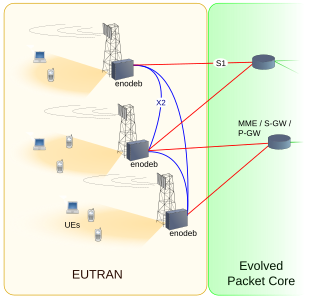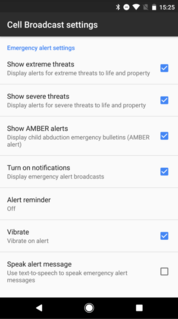Related Research Articles

Enhanced Data rates for GSM Evolution (EDGE) also known as Enhanced GPRS (EGPRS), IMT Single Carrier (IMT-SC), or Enhanced Data rates for Global Evolution) is a digital mobile phone technology that allows improved data transmission rates as a backward-compatible extension of GSM. EDGE is considered a pre-3G radio technology and is part of ITU's 3G definition. EDGE was deployed on GSM networks beginning in 2003 – initially by Cingular in the United States.

General Packet Radio Service (GPRS) is a packet oriented mobile data standard on the 2G and 3G cellular communication network's global system for mobile communications (GSM). GPRS was established by European Telecommunications Standards Institute (ETSI) in response to the earlier CDPD and i-mode packet-switched cellular technologies. It is now maintained by the 3rd Generation Partnership Project (3GPP).

SMS is a text messaging service component of most telephone, Internet, and mobile device systems. It uses standardized communication protocols that let mobile devices exchange short text messages. An intermediary service can facilitate a text-to-voice conversion to be sent to landlines.
The Universal Mobile Telecommunications System (UMTS) is a third generation mobile cellular system for networks based on the GSM standard. Developed and maintained by the 3GPP, UMTS is a component of the International Telecommunication Union IMT-2000 standard set and compares with the CDMA2000 standard set for networks based on the competing cdmaOne technology. UMTS uses wideband code-division multiple access (W-CDMA) radio access technology to offer greater spectral efficiency and bandwidth to mobile network operators.
The Adaptive Multi-Rateaudio codec is an audio compression format optimized for speech coding. AMR speech codec consists of a multi-rate narrowband speech codec that encodes narrowband (200–3400 Hz) signals at variable bit rates ranging from 4.75 to 12.2 kbit/s with toll quality speech starting at 7.4 kbit/s.

Unstructured Supplementary Service Data (USSD), sometimes referred to as "quick codes" or "feature codes", is a communications protocol used by GSM cellular telephones to communicate with the mobile network operator's computers. USSD can be used for WAP browsing, prepaid callback service, mobile-money services, location-based content services, menu-based information services, and as part of configuring the phone on the network.
Adaptive Multi-Rate Wideband (AMR-WB) is a patented wideband speech audio coding standard developed based on Adaptive Multi-Rate encoding, using a similar methodology to algebraic code-excited linear prediction (ACELP). AMR-WB provides improved speech quality due to a wider speech bandwidth of 50–7000 Hz compared to narrowband speech coders which in general are optimized for POTS wireline quality of 300–3400 Hz. AMR-WB was developed by Nokia and VoiceAge and it was first specified by 3GPP.
GSM frequency bands or frequency ranges are the cellular frequencies designated by the ITU for the operation of GSM mobile phones and other mobile devices.
Customized Applications for Mobile networks Enhanced Logic (CAMEL) is a set of standards designed to work on either a GSM core network or the Universal Mobile Telecommunications System (UMTS) network. The framework provides tools for operators to define additional features for standard GSM services/UMTS services. The CAMEL architecture is based on the Intelligent Network (IN) standards, and uses the CAP protocol. The protocols are codified in a series of ETSI Technical Specifications.
3GP is a multimedia container format defined by the Third Generation Partnership Project (3GPP) for 3G UMTS multimedia services. It is used on 3G mobile phones but can also be played on some 2G and 4G phones.

E-UTRA is the air interface of 3rd Generation Partnership Project (3GPP) Long Term Evolution (LTE) upgrade path for mobile networks. It is an acronym for Evolved Universal Mobile Telecommunications System (UMTS) Terrestrial Radio Access, also referred to as the 3GPP work item on the Long Term Evolution (LTE) also known as the Evolved Universal Terrestrial Radio Access (E-UTRA) in early drafts of the 3GPP LTE specification. E-UTRAN is the initialism of Evolved UMTS Terrestrial Radio Access Network and is the combination of E-UTRA, user equipment (UE), and E-UTRAN Node B or Evolved Node B (eNodeB).

Cell Broadcast (CB) is a method of sending messages to multiple mobile telephone users in a defined area at the same time. It is defined by the ETSI’s GSM committee and 3GPP and is part of the 2G, 3G, 4G LTE (telecommunication) and 5G standards. It is also known as Short Message Service-Cell Broadcast (SMS-CB) or CB SMS.
In GSM cellular networks, an absolute radio-frequency channel number (ARFCN) is a code that specifies a pair of physical radio carriers used for transmission and reception in a land mobile radio system, one for the uplink signal and one for the downlink signal. ARFCNs for GSM are defined in Specification 45.005 Section 2. There are also other variants of the ARFCN numbering scheme that are in use for other systems that are not GSM. One such example is the TETRA system that has 25 kHz channel spacing and uses different base frequencies for numbering.
A broadcast control channel (BCCH) is a point to multipoint, unidirectional (downlink) channel used in the Um interface of the GSM cellular standard. The BCCH carries a repeating pattern of system information messages that describe the identity, configuration and available features of the base transceiver station (BTS). These messages also provide a list of absolute radio-frequency channel numbers (ARFCNs) used by neighboring BTSs. This message pattern is synchronized to the BTS frame clock. The minimum BCCH message set is system information messages 2–4, although other messages are normally present. The messages themselves are described in 3GPP Technical Specification 44.018.
Synchronization Channel is a downlink only control channel used in GSM cellular telephone systems. It is part of the Um air interface specification. The purpose of the SCH is to allow the mobile station (handset) to quickly identify a nearby cell and synchronize to that BTS's TDMA structures. Each radio burst on the SCH contains:
Transcoder and Rate Adaptation Unit, or TRAU, performs transcoding function for speech channels and RA for data channels in the GSM network. The Transcoder/Rate Adaptation Unit (TRAU) is the data rate conversion unit. The PSTN/ISDN switch is a switch for 64 kbit/s voice. Current technology permits to decrease the bit-rate. Since MSC is basically a PSTN/ISDN switch its bit-rate is still 64 kbit/s. That is why a rate conversion is required in between the BSC and MSC...
The Um interface is the air interface for the GSM mobile telephone standard. It is the interface between the mobile station (MS) and the Base transceiver station (BTS). It is called Um because it is the mobile analog to the U interface of ISDN. Um is defined in the GSM 04.xx and 05.xx series of specifications. Um can also support GPRS packet-oriented communication.
LAPDm in telecommunications is a data link layer protocol used in GSM cellular networks. LAPDm forms Layer 2 of the Um interface between the Base Transceiver Station and Mobile station, which is to say that it is used in the radio link between the cellular network and the subscriber handset.
Frequency bands for 5G New Radio, which is the air interface or radio access technology of the 5G mobile networks, are separated into two different frequency ranges. First there is Frequency Range 1 (FR1), which includes sub-6 GHz frequency bands, some of which are traditionally used by previous standards, but has been extended to cover potential new spectrum offerings from 410 MHz to 7125 MHz. The other is Frequency Range 2 (FR2), which includes frequency bands from 24.25 GHz to 52.6 GHz.
LTE-M, which includes eMTC, is a type of low power wide area network (LPWAN) radio technology standard developed by 3GPP to enable a wide range of cellular devices and services. The specification for eMTC was frozen in 3GPP Release 13, in June 2016. Other 3GPP IoT technologies include NB-IoT and EC-GSM-IoT.
References
- 3GPP TS 05.01 Physical layer on the radio path; General description
- 3GPP TS 05.02 Multiplexing and Multiple Access on the Radio Path
- http://www.3gpp.org/ftp/Specs/html-info/05-series.htm